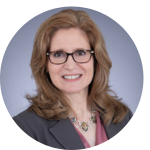
The National Academy of Medicine’s Future of Nursing 2020-2030 Report promotes health equity by addressing many aspects of health disparities, including social determinants of health (SDOH). The study aims to help nurses identify challenges impacting healthcare outcomes, focusing on nurse workforce advocacy for wellness and innovations to support healthcare improvement. The committee has recommended a multidimentional call for action targeting the nation’s healthcare workforce to advance and sustain equitable healthcare processes, systems and education.
We connected with four nursing informaticists to get their perspectives on the barriers and challenges the workforce is experiencing. Here you’ll explore strategies to reduce health disparities and support for digitalization. Our questions focus on the workforce challenges and resources to help advocate for the informaticist role.
 Lisa Stephenson, MSN, R.N.-B.C.
Lisa Stephenson, MSN, R.N.-B.C.
Chief Nursing Informatics Officer
Houston Methodist
Lisa has over 20 years of nursing experience with direct patient care practice in homecare hospice, medical surgical (adult and pediatric), and emergency medicine. She knew she wanted to move into nursing leadership, so she worked in quality as a clinical outcomes coordinator, followed by a position as a nurse manager of medical telemetry unit. In 2011, after experiencing an unexpected and extended EHR downtime as a manager, Lisa worked to develop a resource book and process for downtime that she shared with the other inpatient units. Soon after, she was asked to be the clinical informatics manager for the facility. Lisa wasn't even sure what informatics was! She accepted the position and it's been her passion ever since.
Informatics allows Lisa to serve those at the bedside and improve patient outcomes, all while fostering her love of process improvement through the use of technology. She has worked with amazing people and organizations, like Centura Health, Covenant Health, Mayo Clinic and now Houston Methodist. Being involved in professional organizations like HIMSS has also enabled her to collaborate and learn from industry experts. For the last two years, Lisa has served on the HIMSS Nursing Informatics Committee, and serves as the committee chair for 2023.
1. What is one challenge impacting nurse engagement today? What is one opportunity we have to retain a successful nursing workforce?
The consistent challenge I've seen throughout my career in nursing is how to do more with less. There has always been talk of the looming nursing shortage, with demand outpacing the numbers of new nurses. But it seems the collision of an aging and shrinking workforce coupled with a global pandemic have now made it a reality. With the decrease in resource availability, increases in patient acuity, and increasing workload demands from tasks such as documentation burdens and alert overload, nurses struggle just to stay above water each day.
The good news is that nurses are amazing individuals who are passionate about the care they deliver. This passion drives them forward and ignites innovative opportunities to improve the way nurses work. Nursing informatics is the conduit that can turn these innovative ideas into a new reality. Using their knowledge of clinical workflows and capabilities of emerging technology, informatics can offer solutions to this ongoing challenge.
2. What is your perspective on enhancing the global health ecosystem through digital technologies and effective data usage?
Digital technology capabilities in healthcare are evolving quickly. It is often tempting for clinicians to implement the newest shiny object with promises of making their daily work easier. However, too many times, I've seen the reality set in of underdelivered expectations. This does not have to be the case. Involving organizational informatics resources in these decisions to implement new technology, early in the process, help ensure that the technology will provide the tools and data to clinicians when they need it, and in a way that provides them with the guidance for the next steps in care. Informatics can also help to present data in a way that can be most useful for direct care providers and leaders looking to improve patient outcomes.
3. What healthcare resources and strategies can optimize the workforce’s care coordination and interprofessional collaboration to reduce clinician burnout?
There are a couple of different strategies that can help with care coordination and collaboration to decrease burnout. The first is using technology in developing foundational processes and tools for communication across the care team and management of alerts. Coming up with a consolidated strategy—preferably using one mobile device—for nurses to easily reach care team members they need quickly can cut down tremendously on the back and forth and frustration of getting the responses needed to provide timely care. In addition, consolidating various alarms and alerts through a single portal will allow for a reduction in duplicative alerts, those focused on the right resources, and individualization of alarms based on patient condition.
The second strategy is the use of technology for implementing new care models such as telenursing. A growing number of organizations are finding the benefits of having a telenursing program that supports the inpatient bedside nurse's work. Telenursing programs can help complete some of the more burdensome documentation components, like admission history and screenings. Not only does this relieve the bedside nurse of this task, but since the virtual nurse can be more focused (and uninterrupted), they can receive more complete information upfront, like for case management, and get needed consults to improve care coordination earlier in the patient’s stay.
4. What do you recommend including in nursing curriculum to communicate the understanding of health equity and support advocacy roles for students?
Nursing curriculum has always supported a holistic model of care. However, nursing practice, especially in the inpatient setting, has mostly supported a more one-dimensional focus on physical health. While there has been a steady increase in screenings on mental health, many SDOH concepts have traditionally only been addressed by case managers or social workers. COVID helped shine a light on the health disparities, pushing the concepts of SDOH into the spotlight. In order to make a meaningful impact on these health disparities, SDOH concepts should be taught as key components in ensuring the health of patients. Providing students with real life stories and statistics of certain health conditions that disproportionately impact particular populations will help with this understanding. They should also be taught to challenge inaccurate patient labels, such as "noncompliant," and ask about the reasoning.
Many of the factors with SDOH, such as living situation, transportation and support systems, can point to important components of the treatment plan to be included for successful outcomes. Students would also benefit from an understanding of regulatory requirements such as the most recent for accountable health communities to complete a health-related social screening of inpatients starting in 2024. Nurses have always been patient advocates and now more than ever have an opportunity to ensure that care plans account for a truly holistic model by including the SDOH components. This means not only knowing how to identify these elements, but also how to connect patients to the resources that address them. That being said, this also means that nursing informatics needs to ensure nursing is presented with the tools to easily see SDOH that are potential barriers to health and easily access resources for patients.
 Vicky Tiase, Ph.D., R.N.-B.C., FAMIA, FNAP, FAAN
Vicky Tiase, Ph.D., R.N.-B.C., FAMIA, FNAP, FAAN
Strategic Director, Digital Health and Assistant Professor, Biomedical Informatics
University of Utah Health
Vicky was a nurse, nurse educator and information technology executive at New York-Presbyterian Hospital for over 25 years. She also served as an adjunct assistant professor of health informatics at Weill Cornell Medicine. Vicky’s expertise ranges from leading electronic health records (EHR) implementations and leveraging patient-generated health data to mentoring digital health startups. She volunteers on the boards of the Alliance for Nursing Informatics, American Medical Informatics Association (AMIA) and the Friends of National Institute of Nursing Research (NINR). Vicky was appointed as the informatics expert to the National Academy of Medicine’s Future of Nursing 2030 Committee to envision the nurse’s role in using technology to tackle disparities, promote health equity, and create healthier communities. Her research interests include remote patient monitoring and patient generated health data. These interests bridge her personal life, where she leverages biometric data as a competitive triathlete and triathlon coach.
1. What is one challenge impacting nurse engagement today? What is one opportunity we have to retain a successful nursing workforce?
One challenge is the underappreciation of the nursing voice and nurses' experience. I think the biggest opportunity is to define structures and processes that leverage the innovative solutions that bedside nurses can offer. Providing opportunities for nurses to bring ideas to the table and then include them in the implementation of solutions. Value, worth and inclusion can all elevate the success of nurses in the workforce.
2. What is your perspective on enhancing the global health ecosystem through digital technologies and effective data usage?
Yes, nurses are ready to use tools and data, but many times new nurses are disillusioned by the tools that are provided to them. Validated digital tools that increase efficiencies for clinicians must be implemented faster.
3. What healthcare resources and strategies can optimize the workforce’s care coordination and interprofessional collaboration to reduce clinician burnout?
De-implementation of documentation is critical. Instead of adding to documentation, strategies to leverage technology, virtual care and natural language processing should be implemented. Interoperability must advance for documentation efficiencies. Nurses should be included in workplace responses to public health emergencies, instead of having the response done to them.
4. What do you recommend including in nursing curriculum to communicate the understanding of health equity and support advocacy roles for students?
Real world case studies and solutions must be included in the curriculum and students should be provided practicums to practice such skills. Looking to school nurses as preceptors and examples from the Camden Coalition work would be beneficial.
 Whende M. Carroll, MSN-R.N.-B.C., FHIMSS
Whende M. Carroll, MSN-R.N.-B.C., FHIMSS
Clinical Informatics Advisor
Healthcare Information Management and Systems Society (HIMSS)
Whende is the founder of Nurse Evolution, a health IT information hub established to educate nurses about using emerging technologies, advanced data analytics, and innovation strategies to optimize nursing care delivery to improve the nurse experience. Currently, she serves as the Nursing Knowledge: Big Data Science Policy and Advocacy workgroup co-chair and steering committee member, and is a member of the American Nurses Association's Innovation Advisory Committee for Artificial Intelligence, Augmented Intelligence, and Data Science. Whende is a senior editor at the Online Journal of Nursing Informatics (OJNI), where she writes about nurse value and big data-enabled nursing topics.
1. What is one challenge impacting nurse engagement today? What is one opportunity we have to retain a successful nursing workforce?
There needs to be more time allotted for nurse leadership and mentorship for new nurses. Nurse job satisfaction could be improved with one-on-one mentoring to coach nurses through challenges, such as cognitive and documentation burden that takes nurses away from quality time with patients and caregivers. Mentoring would also help nurses address the moral distress of caring for higher-acuity patients during periods of inadequate staffing in clinical settings.
2. What is your perspective on enhancing the global health ecosystem through digital technologies and effective data usage?
We currently have a digital healthcare divide that equates to a need for more access to technologies, connectivity and literacy about digital health tools worldwide. Nurses can help bridge this gap by becoming literate about digital health tools to teach patients and caregivers about them, and how to use them effectively. Without nurses having digital health knowledge to share, we’ll be unable to close the great divide.
3. What healthcare resources and strategies can optimize the workforce’s care coordination and interprofessional collaboration to reduce clinician burnout?
Nurses and providers can collectively begin to better understand and adopt vaccine and disease surveillance through partnering with public health entities. Proactivity and connectedness will ensure better interprofessional resources and staffing levels to effectively handle global emergencies such as COVID-19. Supporting interoperability policy is an approach that will help further this.
4. What do you recommend including in nursing curriculum to communicate the understanding of health equity and support advocacy roles for students?
Many academic institutions with schools of nursing can and already are promoting equity literacy in courses by ensuring the inclusion of public health knowledge in class activities and projects. To better understand the social and behavioral aspects of people's health, nurses must comprehend the factors that genuinely represent them holistically. SDOH awareness must start with pre-licensure education for nurses to use the concepts in practice.



